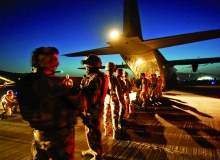
Logistics and operations have long been seen as awkward counterparts. While one cannot exist without the other, there is a long-standing cliché that the two must be at odds. Alexander the Great, the Macedonian king, is said to have claimed that his logisticians were "a humourless lot… They know that if my campaign fails, they are the first ones I will slay." Two millennia later, and while the threat of slaughter has dissipated, the two professions still face a tricky balancing act.
"As a military logistician, you work from the premise that military planners don’t necessarily think of the logistic constraints right from the start," says Major General (Ret’d) David Shouesmith, the UK’s former assistant chief of defence staff for logistic operations. "It’s your job to persuade them that, while it might be a great idea to mount a brigade-sized operation 5,000 miles away, we may only have the capacity to get 120 people there every two days. You need to work together to balance the operational need with the logistic reality."
As armed forces contend with falling defence budgets, the need for integrated planning is ever more crucial. The task falls to logisticians to cast a pragmatic eye over proceedings, and ensure that strategic operational planning occurs from the outset.
"A short-notice contingent operation such as Libya would have required the planners to sit down with the logisticians and ask, ‘how long will the operation last, what’s the sortie rate, what manpower and equipment is needed and what munitions have we got?’," Shouesmith explains. "In this kind of interactive planning the logistician seeks to enable, rather than constrain, the emerging operational plan."
Operational changes
Shouesmith, who now works at PricewaterhouseCoopers as a VP in its PRTM management consultancy division, spent the last part of his military career in joint logistics. His last MoD role had three main strands: planning for current and future operations; providing support for the acquisitions process; and international logistical efforts. This is a challenging time for military logistics. Alongside the difficulties posed by specific conflicts, the past decade has seen tight financial constraints and huge strides in communication technologies. Logistic processes have thus been subject to continuous change. Driving this evolution is the changing face of operations.
"There’s nothing like being deployed in operations – or even more, having to mount a new operation – to drive change for the better," Shouesmith explains. "It’s what I call the ‘operational imperative’. Throughout the defence community, there is a strong consciousness that we must support our guys in the field. The collective effort over the past few years to find the best-possible support, weapons, food, equipment and infrastructure has been immense. Rightly, operations is always king."
Because Iraq and Afghanistan were such large-scale projects, the bulk of logistical effort was directed towards these conflicts. Wherever present provisions failed to match troops’ needs, the disjuncture led to the introduction of new logistic assets; for example, in 2006, when troops were reinforced in Afghanistan, the UK’s Royal Air Force had four Boeing C-17s on lease. Once it emerged that personnel were flying for longer than the lease agreement suggested, the MoD purchased the leased C-17s and ordered another aircraft. Two more swiftly followed, and in February 2012 an order was placed for an eighth.
The MoD has also drastically broadened its counter-IED capabilities. In 2006, troops had little protective mobility equipment, and thus minimal protection against roadside bombs. Since then, development has gained momentum, with Mastiff, Foxhound and Ridgeback vehicles introduced in response to operational imperatives. Of course, any new equipment or strategy must be weighed against its impact on the bottom line. Never has this been more the case than in the years following the financial crisis. The MoD is currently being buffeted by budget reductions, with the coalition government’s Strategic Defence Spending Review (SDSR) prescribing cuts of 8% during 2011-15.
While such measures are far from unusual – the US is looking to slash its defence budget by $600bn over the next decade, and 16 European Nato member states cut spending between 2008 and 2010 – the challenge is not insignificant. As well as reducing soldier numbers, the MoD has retired a host of weaponry early, including Harrier jump jets, Type 22 and 23 frigates and aircraft carrier HMS Ark Royal. There is some debate as to how an austerity-age MoD will be able to respond to its commitments.
Nor are all the SDSR’s decisions going entirely to plan. In May 2012, UK Prime Minister David Cameron approved a major U-turn over the Royal Navy’s new aircraft carriers. While the decision to buy the F-35C variant lay at the heart of the review, the estimated cost of conversion rose from £400m to £2bn, and plans were abolished. Shouesmith, however, is cautiously optimistic about the potential to create new efficiencies: "We’ve got to find smarter, different ways to do things, and that brings about a redesign."
The cuts look to be expediting a pre-existing trend. For some time, the MoD has been working with industry to develop supporting services – equipment support and infrastructure provision along with conventional logistics. Now, as the implications of the budget reductions unfold, new possibilities have surfaced.
"I had a firm view when I was in the MoD that industry could do so much more in the support area, and that’s being seen increasingly in the post-SDSR era," says Shouesmith. "You need military capability where there’s ‘muck and bullets’. If there’s no muck or bullets, then why do you need a highly trained solder, sailor or airman? Our default should be to test whether this is a role we could get industry to do."
Information impact
The final major driver in logistical developments is the ‘information age’. As communications technology advances, civilian logistics have been revolutionised, and it’s likely there will be knock-on effects on the way the military does business. Where the technologies have proven particularly useful is in improving visibility of the battle space. This broadens the scope to place materiel exactly where required, and reduces the need to stockpile emergency provisions.
Information is only part of the equation: in a high-threat situation it is not always possible to exploit all the knowledge available. But the impact on logistics is undeniable. Following the introduction of a new process, the management of the joint deployed inventory, it is becoming simpler to manage all commodities using a single, streamlined system.
The MoD’s next major logistical effort looks to be the end of the Afghanistan conflict, which Shouesmith sees as an order of magnitude more complex than leaving Iraq. Faced with such a large field of operation, the practicalities of removing equipment and infrastructure will likely dominate the community’s efforts for years to come. More broadly, this exodus could signal a change towards what Shouesmith calls a "contingent operations mindset". Ever since British troops invaded Iraq in 2003, the armed forces have been continuously deployed across the globe, with logistics mostly entailing supporting troops abroad; however, post-Afghanistan, there are likely to be far fewer military commitments elsewhere. With little political appetite to deploy people in long campaigns, the UK looks set to maintain a largely home-based armed forces.
The MoD is therefore readying itself for short, sharp interventions. "It’s a fundamentally different thing to do, to be sat in the UK home base waiting for something to happen," says Shouesmith. "You’ve got to be prepared for anything, which is a big change. Everything that derives out of SDSR focuses on reshaping our armed forces so we can respond and react. This explains our investment in carriers, fast jets and C-17s."
Shouesmith will not be drawn into the specifics of particular operations – the decision to send a warship to the Strait of Hormuz; the Libyan bombing campaign; the anti-piracy patrols in the Gulf of Aden; the escalating row over the Falklands. These being politically charged situations, he suggests that it would be wrong to comment on politicians’ decisions. Nonetheless, such scenarios might be seen as clear examples of ‘contingencies’.
"You bundle the Falklands and Iran into that package of potential scenarios that were swept up in the SDSR," he says. "As the armed forces restructure, they will have the capabilities to first be able to mount those operations, and then support them."
With the targets of Future Force 2020 in sight, work is underway to make those goals a reality. Soon to be unveiled is an equipment plan specifying the MoD’s support and logistic capabilities for the coming era. It is impossible to prepare for every eventuality, but Shouesmith is confident that the plan will be as right as it can be. "As logisticians, you have to manage the tension between commitment and reality," he says. "You do that by being clear on what the facts are. Effectively, you feed in the art of the possible."
This is an objective that bodes well for the straitened times ahead.
This article was first published in our sister publication Defence & Security Systems International.




